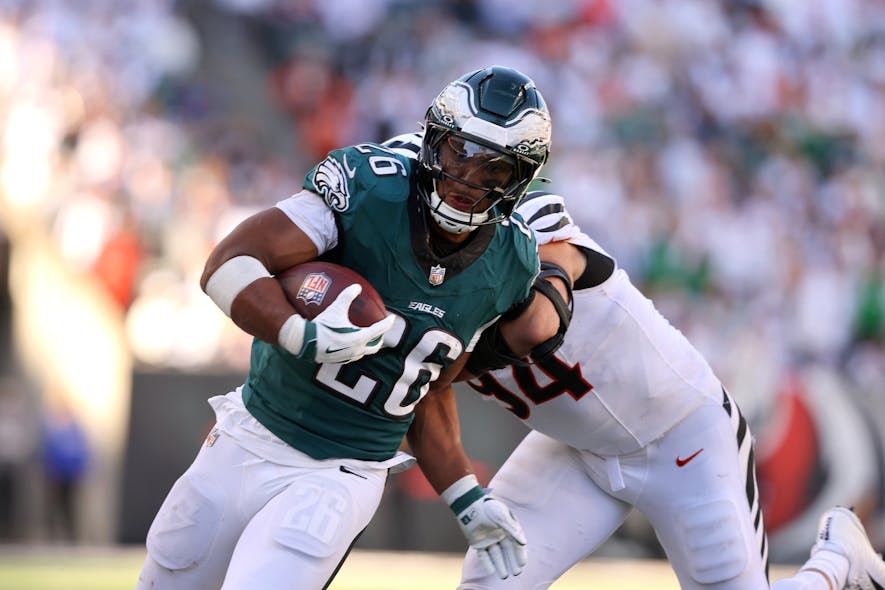RELATED: See lessons learned at all other positions:
Quarterbacks | Running Backs | Wide Receivers | Tight Ends
In this week's roundtable series, I asked our Footballguys staff to discuss their fantasy New Year's resolutions for each position and their overall takeaways for approaching drafting in 2025.
Yesterday, we talked about the tight end position. In today's article, we share our thoughts on the running back position.
Lessons Learned at Running Back
Drafting Running Backs on New Offenses Worked in 2024
Dave Kluge: It still feels too early to thoroughly digest what just happened with running backs. For years, drafting aging running backs on new teams has been an easy-to-avoid landmine. This year, three of the top-five finishers were suppressed in fantasy drafts for that exact reason. Saquon Barkley, Derrick Henry, and Josh Jacobs were all historical outliers. Do we chalk it up as a fluke? Or do we kick ourselves for fading elite talents on good offenses? I lean toward the latter. When assessing running backs, the resolution should be to not favor spreadsheets and data over common sense.
Jeff Bell: Get bell cows.
Situation Matters. Saquon Barkley, Derrick Henry, and Josh Jacobs had subpar 2023 seasons. They had dramatic environmental upgrades. The result was much stronger 2024 performances, finishing RB1, RB2, and RB6.
The more significant takeaway is a shift toward more bell cow usage. Between 2017 and 2023, the NFL averaged 6.7 players over 290 touches. The highest seasons were nine in 2017 and 2019, while the fewest was four in 2021. In 2024, 13 backs went over 290 touches. Understandably, with more touches, there are more fantasy points. In 2021, James Conner finished as the RB5 at 15.9 and 239.2 half PPR points. Those numbers would have been tied with Kyren Williams and Joe Mixon for RB8 in 2024. The RB1 threshold for a Top 12 finish in 2021 sat just at 200 points; in 2024, that would be RB18.
RB24 is my threshold, viewing a 12-team league as having two starting running back positions. Eliminating committee backfields does two things. First, it creates more potential RB1s, i.e., players capable of scoring inside the Top 12 (ideally the Top 8) at the position. Second, it raises the bar dramatically on start-ability for the RB2 field. If half the league starts two backs who would have been RB1s just three seasons ago, the disadvantage of a patchwork, ZeroRB team increases.
Think of the league as 32 potential fantasy RB1s. Any team (outside of Detroit) splitting carries eliminates themselves from the RB1 pool. In an arena with every backfield split, there are 64 available options for 24 primary spots. Supply overflows. If half of those teams suddenly shift to bell cow usage, the pool goes to 17* (Detroit), but the other 16 committee backs pose a different value proposition. Starting a committee running back averaging 10 PPG is very different than a bell cow averaging north of 15 PPG (roughly similar to starting Josh Allen vs Tua Tagovailoa). Starting two committee running backs in a league where most have two bell cows becomes a different animal.
Should We Fade Running Backs on New Offenses in 2025?
Jason Wood: Running back strategy was where most leagues were won and lost in 2024. Fortunately for our subscribers, we strongly advocated for veteran free agents like Saquon Barkley and Derrick Henry. If you followed our advice, you were sitting pretty. Add Joe Mixon and Josh Jacobs to the mix, and the trend becomes clear: betting on older veterans changing teams at their discounted ADPs was a massive edge because so many managers overlooked them.
You were also rewarded if you invested in incumbents like Alvin Kamara, Chuba Hubbard, and Kyren Williams. But here's where things get interesting: my New Year's resolution is to likely fade these same players in next year's draft. Fantasy managers tend to overreact to what happened the prior year, and the same phenomenon that made these running backs incredible values in 2024 is likely to make them overvalued in 2025.
We can expect workhorse running backs to dominate the first two rounds of drafts, which will likely open up value elsewhere—most notably at receiver.
Jeff Blaylock: I resolve to avoid paying a premium for running backs older than 27 in 2025 despite their success in 2024. Six such running backs eclipsed 240 fantasy points using point-per-reception (PPR) scoring, the most in a season since 2002. Four of those backs – James Conner, Derrick Henry, Aaron Jones, and Alvin Kamara – will be 30 or older next season. Since 2002, just 13 running backs in their 30s have scored at least 240 PPR points, according to Stathead's data. I'm not necessarily betting against top-12 seasons for these players, but I'm not overpaying for the possibility of it.
For dynasty, I resolve to keep finding first-round talent in the third round of rookie drafts. Last year, I drafted Bucky Irving in the third round of all my rookie drafts, and he finished as the RB14 in PPR scoring and RB1 of the rookie class. Two years ago, it was Puka Nacua. Who will it be in 2025? Among the running backs, Texas Tech's Tahj Brooks, Arizona State's Cam Skattebo, and Miami's Damien Martinez are my way-too-early picks right now. If a third-round pick doesn't hit, it costs little. If he does hit, then the value relative to cost is immense.

